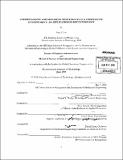| dc.contributor.advisor | Charles Cooney and Ernst Berndt. | en_US |
| dc.contributor.author | Lin, Amy C. (Amy Chaimin), 1980- | en_US |
| dc.contributor.other | Leaders for Global Operations Program. | en_US |
| dc.date.accessioned | 2010-10-12T17:58:57Z | |
| dc.date.available | 2010-10-12T17:58:57Z | |
| dc.date.copyright | 2010 | en_US |
| dc.date.issued | 2010 | en_US |
| dc.identifier.uri | http://hdl.handle.net/1721.1/59173 | |
| dc.description | Thesis (M.B.A.)--Massachusetts Institute of Technology, Sloan School of Management; and, (S.M.)--Massachusetts Institute of Technology, Dept. of Mechanical Engineering; in conjunction with the Leaders for Global Operations Program at MIT, 2010. | en_US |
| dc.description | Cataloged from PDF version of thesis. | en_US |
| dc.description | Includes bibliographical references (p. 56-57). | en_US |
| dc.description.abstract | For many biotech drugs, minimal competition has led to significant margins. Genentech's legacy product, however, faces intense competition from six other competitors. Competition necessitates contracting to ensure patient access to the product but this results in price erosion. An increase in discounting and subsequent price erosion in recent years has prompted a need to better understand account level profitability. Given a highly dynamic and complex payer and distribution network, it is difficult to determine the contribution of each vial that is sold, such that the profitability of some vials is in question. As other biotech drugs begin to face similar competitive market dynamics, an analysis of Genentech's product brings timely insight into understanding and managing profitability in a competitive environment within the biotechnology sector. System dynamics modeling is used to analyze the key attributes of a competitive environment. It highlights two important and related observations: that increased market share does not necessarily lead to increased profitability, and that contract wins do not always result in increased sales. A framework is introduced to determine account level profitability. By using activity-based accounting to allocate costs, the true profit of each account is determined. Results show that the degree of profitability varies widely, further reinforcing the notion that account specific profits rather than average profits are a more accurate measure of performance. Finally, to assist decision makers in the ongoing process of promoting sound business decisions, tools are created that incorporate the insights gained in this analysis. Both an account specific marginal profit model and a dashboard will help to ensure that future decisions lead to long-term profitability. | en_US |
| dc.description.statementofresponsibility | by Amy C. Lin. | en_US |
| dc.format.extent | 57 p. | en_US |
| dc.language.iso | eng | en_US |
| dc.publisher | Massachusetts Institute of Technology | en_US |
| dc.rights | M.I.T. theses are protected by
copyright. They may be viewed from this source for any purpose, but
reproduction or distribution in any format is prohibited without written
permission. See provided URL for inquiries about permission. | en_US |
| dc.rights.uri | http://dspace.mit.edu/handle/1721.1/7582 | en_US |
| dc.subject | Sloan School of Management. | en_US |
| dc.subject | Mechanical Engineering. | en_US |
| dc.subject | Leaders for Global Operations Program. | en_US |
| dc.title | Understanding and managing profitability in a competitive environment : an application in biotechnology | en_US |
| dc.type | Thesis | en_US |
| dc.description.degree | S.M. | en_US |
| dc.description.degree | M.B.A. | en_US |
| dc.contributor.department | Leaders for Global Operations Program at MIT | en_US |
| dc.contributor.department | Massachusetts Institute of Technology. Department of Mechanical Engineering | |
| dc.contributor.department | Sloan School of Management | |
| dc.identifier.oclc | 659780829 | en_US |

